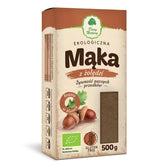Cocoa - Facts and Myths. How does it affect our health?
CONTENTS
- The history of cocoa
- What exactly is cocoa?
- Cocoa - nutritional content
- Cocoa and cardiovascular diseases
- Think of cocoa
- Cocoa and kidney stones
- Cocoa, against stress, good mood and libido
- Who should limit the consumption of cocoa beans?
- Summary
Today, cocoa is strongly associated with all kinds of confectionery, especially chocolate. For a long time, especially in the People's Republic of Poland, chocolate was considered a truly luxurious and unobtainable commodity. Today, the presence of many types of chocolate on store shelves is less surprising than a kind of standard. In this article, we will attempt to examine cocoa and reveal what is true about it and what can be shrouded in myth.
The history of cocoa
The history of cocoa dates back to ancient times. The Mayans and Aztecs living in South America were already aware of its health-promoting properties. Therefore, they used it for medicinal purposes, but also in religious ceremonies. Eventually, cocoa beans became so valuable that they were used as currency. Cocoa beans came to Europe with Christopher Columbus and his crew. Originally, cocoa was consumed in the form of infusions, similar to those prepared by the inhabitants of South America. However, this liquor was not accepted at European courts because of its bitter taste. It wasn't until the 19th century that it reached a wider circle of enthusiasts with the development of an innovative method for extracting fat from grain. The finished cocoa found its way into chocolate production. The first bars were produced in Switzerland in 1876.
What exactly is cocoa?
Cacao is very finely ground cocoa fruit. This tree grows primarily in tropical and subtropical climates. Currently, it is a plant typically cultivated by growers in Africa, South America, or the equatorial forests of North and Central America. There are over 20 species of cacao, but interestingly, only one is suitable for making chocolate. Specifically, the Theobroma species cacao L.
The cocoa berries are cut open immediately after harvest. This allows the extraction of granules, which are then fermented in special containers for a period of 3 to 6 days. After this time, they acquire a characteristic aroma and flavor and are sufficiently dry. Further processing usually takes place in the destination countries. After the raw material has been transported, the beans are dried again, their shells removed, and then the excess fat is extracted. The thus prepared raw material is ground into powder, which we can rightly call cocoa. The byproduct of this process is cocoa butter.
Cocoa - nutritional content
High-quality cocoa is a truly valuable source of nutrients. 100 grams of this popular powder contains 228 kcal, including 19 grams of protein. It also contains 13.7 grams of fat and 57 grams of carbohydrates. Importantly, only 1.75 grams of this total are simple sugars. Even more importantly, despite the fact that cocoa is a plant, most of its fats are saturated fats, which can have adverse effects on the cardiovascular system. Cocoa is also rich in fiber (37 g/100 g). It also contains valuable vitamins from groups B, E, and K. Its high folic acid content is noteworthy. As for chemical elements, 100 grams of cocoa contains up to 500 mg of magnesium, as well as high levels of calcium, phosphorus, potassium, and iron.
Cocoa and cardiovascular diseases
Cocoa is a source of antioxidant compounds (including flavanols and procyanidins), which have a positive effect on the proper functioning of the circulatory system. These compounds relax blood vessels, facilitate blood flow, neutralize the effects of so-called bad cholesterol, and prevent the formation of blood clots that clog blood vessels. Recent research also suggests that consuming plenty of plant-based foods may reduce the risk of many cardiovascular diseases, including ischemic heart disease, hypertension, stroke, and atherosclerosis.
100g of cocoa contains 1400mg of flavanols and procyanidins, while dark chocolate contains approximately 170mg. It is believed that even a small amount of dark chocolate can have a therapeutic effect. This is due to its properties that reduce oxidative stress, which has a degenerative effect on the entire body.
Think of cocoa
Scientists at Columbia University Medical Center (CUMC) published their research on the effects of cocoa on memory in the journal Nature Neuroscience. They focused particularly on older people. They showed that cocoa can help slow brain degeneration and thus maintain mental performance longer. All thanks to the flavonols (antioxidants) it contains. Their study involved 37 healthy people between the ages of 50 and 69. The volunteers were divided into two groups: the first took high doses of flavonols, while the second group took very low doses: 900 mg and 10 mg per day, respectively. Three months after the start of the experiment, the researchers conducted the test. To their surprise, the memory and thinking skills of the people in the first group improved significantly, while no significant differences were observed in the control group. The author of the study, Dr. Adam M. Brickman, was under no illusions about the possible health-promoting ingredients of cocoa. However, he says, further research on a larger scale is needed.
Cocoa and kidney stones
The famous component of cocoa , theothrombin, is known primarily for its harmfulness to our pets. Despite this, it has many health-promoting properties. One of them is undoubtedly its beneficial effect on kidney function. According to studies, theothrombin can prevent the formation of deposits in the urinary tract, but also in the kidneys. In this way, it can significantly reduce the risk of kidney stones. It is worth noting that to achieve a therapeutic effect, you must consume at least 20 grams of dark chocolate per day. This amount can be potentially harmful for people who are overweight or diabetic, so be sensible.
Teothrombin has another important property: It is more than three times more effective than codeine in treating chronic cough and asthma. Scientists suspect that this is due to the blockade of sensory nerve endings, which suppresses the cough reflex.
Cocoa, against stress, good mood and libido
Despite its content of stimulants such as caffeine and theobromine, cocoa reduces stress. The relaxing effect is attributed to the presence of valeric acid, which has a calming effect. Furthermore, thanks to its high magnesium content, it has calming properties and can be a good adjunct to treatment for mild depression.
Serotonin is responsible for our good mood. It is synthesized from tryptophan. Cocoa contains significant amounts of tryptophan, which can also have a positive effect on our well-being and our perception of the world around us.
Theobromine has been used as a natural libido booster and also as an aphrodisiac. This cacao-based beverage was known in South America centuries ago. Theobromine works similarly to caffeine. Both substances increase the release of neurotransmitters such as serotonin, adrenaline, and norepinephrine. They effectively eliminate fatigue but also influence the rate of blood flow in the body.
Who should limit the consumption of cocoa beans?
First and foremost, of course, are those allergic to cocoa . Since it's a fairly common allergen and found in many products, you should check labels carefully. Patients with high blood pressure and sleep problems should also limit consumption due to the caffeine and theobromine content.
Cocoa also has astringent properties, which is why it is not particularly recommended for conditions such as hemorrhoids, heartburn, chronic constipation or gastroesophageal reflux disease.
It should also be avoided by patients who are overweight or obese, as well as by diabetics.
Summary
Objectively speaking, cocoa is one of the healthiest sweets, along with honey. However, this rule only applies if we choose a high-quality product. Cocoa itself can have a very positive effect on our well-being and performance, or reduce the risk of potential illnesses. Remember that it is not a medicine in itself, but rather a complement to a healthy diet and possible treatment. Let's take advantage of its properties together and remember possible side effects.
THE PUBLISHER'S CHOICE
Dried plums 1 kg BIOGO
- €7,01
- €7,01
- Unit price
- / per
Dried White Mulberries 500 g ORGANIC
- €5,84
- €5,84
- Unit price
- / per
Almonds 1 kg BIOGO
- €11,69
- €11,69
- Unit price
- / per
Cranberries sweetened with apple juice organic 1 kg BIOGO
- €16,37
- €16,37
- Unit price
- / per
Dried dates 1 kg BIOGO
- €4,21
- €4,21
- Unit price
- / per
Unpeeled buckwheat groats 1 kg BIOGO
- €2,81
- €2,81
- Unit price
- / per
Walnuts 800 g BIOGO
- €8,65
- €8,65
- Unit price
- / per
Peeled sunflower seeds 1 kg BIOGO
- €3,04
- €3,04
- Unit price
- / per
PULLED ORGANIC SUNFLOWER SEEDS 1 KG BIOGO
- €4,44
- €4,44
- Unit price
- / per












































































































































